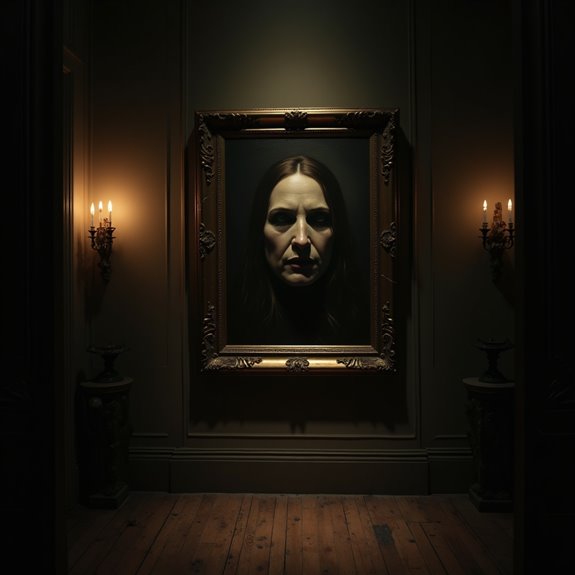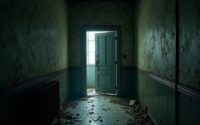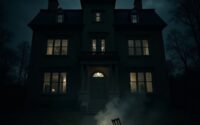Do Haunted Paintings Really Carry Curses?
The debate surrounding haunted paintings raises intriguing questions about art and its connection to the supernatural. Some believe certain artworks harbor curses that can impact their owners. From the chilling tales of “The Crying Boy” to the unsettling “Hands Resist Him,” these narratives blur the lines between myth and reality. As stories unfold, one wonders just how much emotional energy and historical context shape these eerie legacies. What really lies behind these haunted canvases?
Introduction

Throughout history, art has often been seen as a gateway to the supernatural, as tales of haunted paintings and their eerie curses have captivated imaginations. Many believe that certain artworks possess dark energies or are linked to tragic events, drawing viewers into their mysterious domains. These stories often include artists who met untimely ends, or portraits whose subjects seem to come to life at night. Enthusiasts and skeptics alike have flocked to galleries and haunted locations, keen to witness these phenomena firsthand. Curiosity surrounding these cursed canvases fuels a culture of exploration, sparking debates about the thin line between art and the otherworldly. Ultimately, the allure of haunted paintings continues to provoke fascination and fear in equal measure.
Cursed Artwork From 16TH Century

The 16th century birthed some of the most intriguing yet sinister artworks, many of which have become notorious for their supposed curses. Artists like Hieronymus Bosch and Michelangelo sparked fascination with their vivid depictions of the human experience, often intertwined with themes of sin and morality. Some believe that pieces such as Bosch’s “The Garden of Earthly Delights” hold dark energies, suggesting that viewers might fall prey to their seductive imagery. Similarly, Michelangelo’s “The Last Judgment” evokes powerful emotions, leading some to feel an eerie connection to the macabre. These artworks, shrouded in mystery and folklore, continue to captivate art enthusiasts while raising questions about the supernatural forces said to linger within their very brushstrokes.
Notable Cases or Sightings

While many art aficionados admire renowned pieces for their aesthetic value, some have encountered unsettling experiences that blur the line between admiration and fear. One notorious example is “The Crying Boy,” a painting in England linked to numerous house fires. Owners claim that the painting weeps tears, foretelling disaster. In another case, “The Hands Resist Him,” a work known for eerie imagery, allegedly caused nightmares and strange occurrences for those who viewed it. Visitors of the “Portrait of a Young Girl” reported sudden feelings of unease and even illness upon gazing at the piece. These chilling stories have fueled debates about the potential for cursed artwork, leaving collectors and enthusiasts haunted by the idea that some paintings hold dark secrets.
Common Theories or Explanations
Many art enthusiasts ponder why certain paintings seem to carry an unsettling aura or provoke negative reactions. One common theory suggests that the emotional energy of the artist can imbue a piece with a haunting presence. If the creator experienced trauma or deep sorrow while painting, viewers might feel those emotions resonating through the artwork. Another explanation revolves around the historical context; paintings linked to tragic events or cursed tales often evoke dread. Supernatural enthusiasts argue that some artworks act as conduits for spirits, capturing their essence within the canvas. Additionally, psychological factors play a role; viewers might project their fears onto a painting, amplifying its perceived eeriness. Ultimately, the mystery surrounding haunted paintings often stems from a blend of emotion, history, and individual interpretation.
Frequently Asked Questions
Can Anyone Become Cursed by a Haunted Painting?
He believes anyone can be affected by a haunted painting, as its energy might resonate with vulnerabilities. Though it’s rare, those who engage deeply with such art could experience unsettling sensations or emotions.
How Do I Know if a Painting Is Cursed?
He can look for unsettling emotions, strange occurrences, or uncomfortable vibes while viewing a painting. Researching its history might reveal past owners’ experiences, helping him decide if the artwork might be cursed or not.
Are Haunted Paintings More Common Than Other Cursed Objects?
Haunted paintings aren’t necessarily more common than other cursed objects; however, their imagery and emotional depth often captivate people’s imaginations. Many find intriguing stories and mysterious occurrences surrounding various artifacts, making them equally fascinating.
What Should I Do if I Own a Cursed Painting?
If someone owns a cursed painting, they should consider consulting an expert in paranormal activity, cleansing the space, and possibly donating or disposing of the artwork to minimize any negative impact on their life.
Do Haunted Paintings Have a Specific Price Range or Value?
Haunted paintings typically range in price from a few hundred to several thousand dollars, depending on the artist, historical significance, and perceived supernatural reputation. Collectors often pay premium prices for pieces linked to eerie tales.


